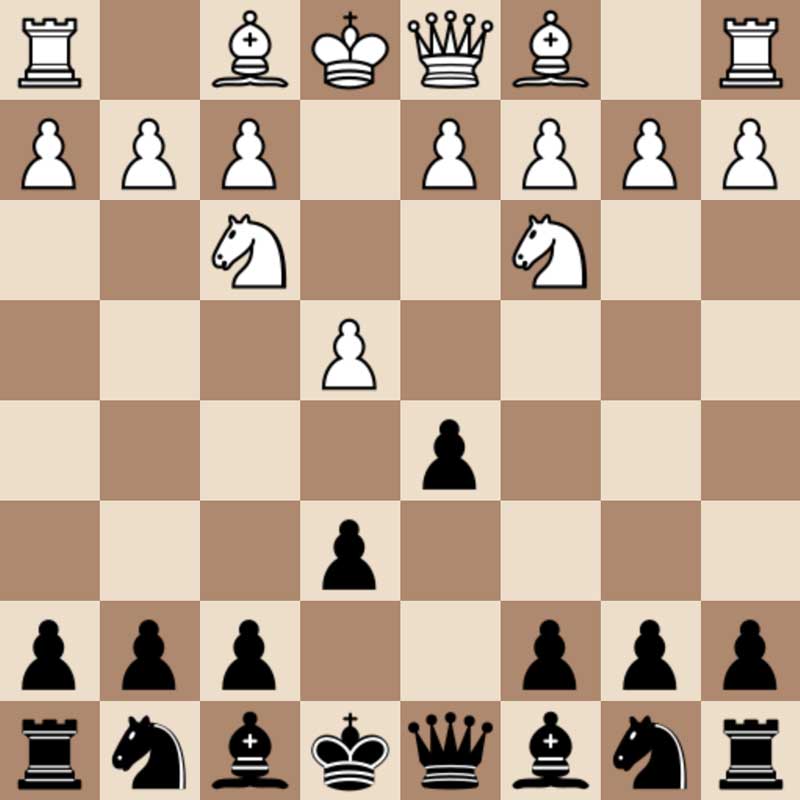The Knight variation of the French Defense is one of those rare lines played by White pieces to surprise the Black player. It begins with 1. e4 e6 2. Nf3 d5 3. Nc3 or transposes to the same after 1. e4 e6 2. Nc3 d5 3. Nf3. Whatever the move order, White commits the development of both their knights instead of grabbing the centre with d4.
How does Black respond to this? What is White’s main intention behind going for this, instead of the mainlines? All of this has been covered in the article below.
White’s Main Intention Behind Playing The Knight Variation
Surprise Weapon
This line is employed less frequently than the mainline starting with 2.d4. So the White player is looking to avoid theoretical discussions when they opt it. Also it can come in handy as a surprise weapon.
Only to avoid Winawer
The Winawer is one of the most annoying lines that the White players who play the mainline with 3.Nc3 have to face. So to avoid it, such players choose the move order employed in the Knight Variation.
These players are comfortable playing other French lines, except for the Winawer.
Here’s what the ideal transposition for them would look like.
With this, White has successfully avoided the Winawer. But, we will show you a way to punish these players for avoiding the mainline. At the same time, if you are comfortable playing this position with the Black pieces, it is absolutely fine to do so.
Keeping Options Flexible With The D-Pawn
Often White’s setup becomes predictable when they play 2.d3(The King’s Indian Attack Setup) or 2.d4(The mainline of French). To avoid that, the White players might employ this line to keep their options open, waiting for Black to reveal their intentions.
Now let’s see how Black can react against it.
How Should Black Respond To The Knight Variation?
Black has more than one acceptable way to play against this line. For instance on the 3rd move, they can play 3…Nf6, 3…dxe4 or 3…Bb4.
All of these are very interesting options. However, Black has a very strong line at their disposal that often gives them a chance to fight for something more than equality.
We discovered this idea in the excellent book – Grandmaster Repertoire: The French Defense by Emmanuel Berg. We are thankful for the author and his team for showing the best way to continue against this line.
Black’s powerful response to the Knight variation in the French Defense is to play
3…d4!
Attacking the knight and exploiting the fact that White didn’t play d4 themselves. White’s most common reaction is –
4. Ne2
Retreating to any other square makes less sense. Black responds with
4…c5
And now White has three options.
5. d3 (The Ugly)
5. Ng3 (The Standard)
5. c3 (The challenging)
5. d3 (The Ugly)
This leaves White with at least one poorly placed minor piece. The problem is what to do with the f1-bishop or g3-knight? If White plays g3-Bg2 to develop their bishop, the e2-knight will be left unhappy. While if they go Ng3, the Bf1 will be developed to e2, which is an extremely passive square for it.
Black could continue developing their piece with 5…Nc6 and follow the plan that’s given after 5.Ng3.
5. Ng3 (The Standard)
This is often the move, you will face. The best way to react is to stop White from developing their light squared bishop with…
5…a6!
The light squared bishop is where White’s problem is coming from. If White now plays 6.Bc4, Black responds with the strong 6…b5. The play could go on
6. a4(stopping …b5) Nc6 7. Bc4 Bd6 8. d3 Nf6 9. Qe2(threatening e5)
9…Qc7! (Stopping e5)
10. O-O O-O 11. Bd2 Nd7!
This is the crucial move, Black side-steps all the threats associated with e5 and strengthens the control over that square. In future, Black can expand on the queenside.
5. c3 (The Challenging Option)
This is the most challenging move as per the book and Black has to know what to do.
5… Nf6!
This is what the author Emanuel Berg recommends in his book on French Defense. There are a few concrete lines you must remember.
6. cxd4
Another option is to go 6. e5, then Black plays 6…Nfd7. Black has nothing to worry about because the White pawn on e5 will soon drop off. If White goes 7.cxd4 cxd4 8. Nxd4, then 8…Nxe5! Black uses tactics! Now if White recaptures with 9.Nxe5, they lose their d4-knight with 9…Qxd4. Black is fine in that position as 10.Bb5+ is met with the simple 10…Nd7.
6…cxd4 7.Nexd4 Nxe4 8.Nxe6
This is something your opponent could play fast, but there’s nothing to worry about. Black is absolutely fine. All you have to do is to play simple developing chess.
8…Bxe6 9.Qa4+ Nc6 10.Qxe4 Qd5!
This might come as a surprise, since Black is a pawn down and willingly offers a queen trade. However, they keep the initiative and practically their position is much easier to play. White is lagging behind in development.
11. Qxd5 Bxd5
Black keeps a small edge despite being a pawn down, thanks to their better development. Their next moves will be …0-0-0, …Bc5 and …Rhe8 with enormous pressure on White’s position.
While you will need to memorize some variations, you will have an easier game with the Black pieces. Apart from the book, we also researched a few games but couldn’t find anything better.
The book covers a few of the lines in more detail, but we believe this is enough to know how to play against 1.e4 e6 2.Nf3 d5 3.Nc3.


